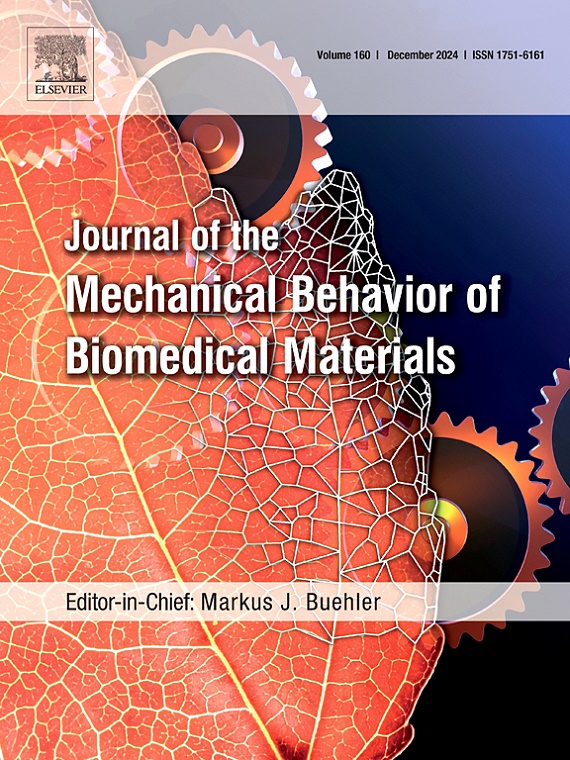Predicting rat lumbar vertebral failure patterns as synthetic μCT images using a deep convolutional generative adversarial network
IF 3.3
2区 医学
Q2 ENGINEERING, BIOMEDICAL
Journal of the Mechanical Behavior of Biomedical Materials
Pub Date : 2025-06-26
DOI:10.1016/j.jmbbm.2025.107116
引用次数: 0
Abstract
This study aims to develop a generative deep learning (DL) model to predict fracture patterns through creation of synthetic 3D μCT images of fractured rat lumbar vertebrae. The proposed model is a 3D conditional generative adversarial network (cGAN). The dataset contained sequential 3D μCT images of rat lumbar vertebrae acquired during axial compressive loading (unloaded, after 1500 μm of displacement, after fracture). Three experiments were run: unloaded input predicting 1500 μm, 1500 μm predicting fracture, and unloaded predicting fracture. The cGAN was trained on 64 μCT images of rat lumbar vertebral motion segments and was validated on 8 images. Quantitative metrics (dice similarity coefficient (DSC), Jaccard index (JAC), Fréchet inception distance (FID), structural similarity index measure (SSIM)) assessed predicted image quality. Qualitative measures investigating fracture location and disease severity (or lack thereof) were also assessed. The unloaded to 1500 μm experiment generated realistic examples of loaded (unfractured) rat vertebrae. These included maintenance of the presence of metastatic disease when relevant and yielded the best quantitative metrics. The 1500 μm to fracture experiment performed significantly better on the FID and SSIM metrics than the unloaded to fracture configuration. The 1500 μm to fracture experiment predicted more true positive fractures and fewer false negative fractures than the unloaded to fracture experiment. Both fracture experiments had a low false positive fracture prediction rate (<10 %). The presented cGAN generates realistic rat lumbar vertebrae failure patterns as 3D μCT images and shows promise for future generative DL applications to model damage behaviour of biological structures.
基于深度卷积生成对抗网络的大鼠腰椎衰竭模式合成μCT图像预测
本研究旨在通过合成大鼠腰椎骨折的三维μCT图像,建立一种生成式深度学习(DL)模型来预测骨折模式。所提出的模型是一个三维条件生成对抗网络(cGAN)。数据集包含大鼠腰椎轴向压缩加载(卸载、1500 μm位移后、骨折后)时的连续3D μCT图像。进行了3个实验:卸载输入预测1500 μm、1500 μm预测裂缝、卸载预测裂缝。cGAN在64张大鼠腰椎运动节段的μCT图像上进行训练,并在8张图像上进行验证。定量指标(骰子相似系数(DSC), Jaccard指数(JAC), fr起始距离(FID),结构相似指数(SSIM))评估预测图像质量。定性测量调查骨折位置和疾病严重程度(或缺乏严重程度)也进行了评估。卸载至1500 μm的实验生成了加载(未骨折)大鼠椎骨的真实示例。这些包括在相关的情况下维持转移性疾病的存在,并产生最佳的定量指标。1500 μm至裂缝的实验在FID和SSIM指标上的表现明显优于未加载至裂缝的实验。1500 μm断裂实验比无载荷断裂实验预测出更多的真阳性裂缝和更少的假阴性裂缝。两种断裂实验的假阳性断裂预测率均较低(10%)。所提出的cGAN生成真实的大鼠腰椎衰竭模式作为3D μCT图像,并有望在未来的生成DL应用中模拟生物结构的损伤行为。
本文章由计算机程序翻译,如有差异,请以英文原文为准。
求助全文
约1分钟内获得全文
求助全文
来源期刊

Journal of the Mechanical Behavior of Biomedical Materials
工程技术-材料科学:生物材料
CiteScore
7.20
自引率
7.70%
发文量
505
审稿时长
46 days
期刊介绍:
The Journal of the Mechanical Behavior of Biomedical Materials is concerned with the mechanical deformation, damage and failure under applied forces, of biological material (at the tissue, cellular and molecular levels) and of biomaterials, i.e. those materials which are designed to mimic or replace biological materials.
The primary focus of the journal is the synthesis of materials science, biology, and medical and dental science. Reports of fundamental scientific investigations are welcome, as are articles concerned with the practical application of materials in medical devices. Both experimental and theoretical work is of interest; theoretical papers will normally include comparison of predictions with experimental data, though we recognize that this may not always be appropriate. The journal also publishes technical notes concerned with emerging experimental or theoretical techniques, letters to the editor and, by invitation, review articles and papers describing existing techniques for the benefit of an interdisciplinary readership.
 求助内容:
求助内容: 应助结果提醒方式:
应助结果提醒方式:


